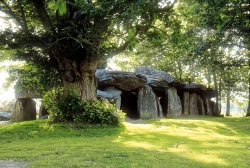 Perhaps inspired by Astérix, Brittany has a whole network of waterways that is entirely independent of the rest of the French network in administrative terms. During the summer months, the locks in the region are open every day without exception, even on bank holidays.
Perhaps inspired by Astérix, Brittany has a whole network of waterways that is entirely independent of the rest of the French network in administrative terms. During the summer months, the locks in the region are open every day without exception, even on bank holidays.
The network enables tourists to sail from the Channel to the Atlantic, or vice-versa, 84km along the Ile et Rance Canal, through 48 locks to the Vilaine Canal for 90km, through 13 locks, and from east to west, or vice-versa, along the Nantes-Brest Canal for 208km, through 98 locks onto the Blavet for 57km, through 28 locks.
Anjou boasts some 275km of waterways reserved exclusively for leisure sailing - 11km along the Maine, with one lock, 18km along the Oudon, three locks, 126km along the Sarthe, 20 locks, and 120km along the Mayenne, with 45 locks.
The region is also very easily accessible by road, TGV rail service and air (regular and low-cost routes).
The region of Brittany, a land of myth and legend where ancestral traditions live on to this day, has managed to preserve its language, its customs and the folklore of its past. This land of magic and mystery will overwhelm you with its wealth and its incredible environment, drawing its originality from the multiple and varied influences that have marked its past. You can't fail but be taken in by the Breton legends that have stemmed from Celtic tales passed down through the generations.
The must-sees of the Brittany - Anjou region by boat
Lying just a few hours from Paris, Anjou will charm you with its sense of easy living, its gastronomy, its castles and its abbeys, providing an opportunity to explore the region's rich and authentic heritage.
- The quality of Brittany's restaurants is largely influenced by its proximity to the ocean. Some of the region's culinary delights include Cancale oysters, shellfish and every imaginable kind of fish, not forgetting the wonderful Breton far cakes, crêpes, galettes, cider and calvados.
- The Armorica Regional Natural Park and the Brière Regional Natural Park are home to 69 wild mammal species, over 250 bird species and over 40 river fish species.
- Keen to offer amateur sailors the best possible welcome, 25 of the towns located along the banks of Brittany's navigable canals and rivers have made a commitment to extending a very warm welcome to visitors to the region. These canals and rivers have been perfectly redeveloped to cater for tourists, who are now the sole users of these waterways.
- It was certainly not by chance that the kings of France chose to build their sumptuous dwellings in the UNESCO World Heritage-listed Loire Valley. Indeed, this magnificent region is now home to a plethora of castles, manors, mills and abbeys, not to mention a total of three regional natural parks and one interregional park.

A few stops during your cruise in Brittany - Anjou
 The Brittany-Anjou region is a hotbed of nature, mythology, architecture and good living, among other things, and you'll certainly need more than a week to experience everything it has to offer!
The Brittany-Anjou region is a hotbed of nature, mythology, architecture and good living, among other things, and you'll certainly need more than a week to experience everything it has to offer!
A classified City of Art and History, Nantes is the seat of the magnificent castle of the Dukes of Brittany and also boasts a whole host of culinary specialities such as the famous LU butter biscuits and the BN sandwich biscuits so often associated with one's childhood. Furthermore, 90% of French lily of the valley is produced here.
Arriving by boat, you will pass by the southern façade of Josselin castle, known for being the most beautiful in Brittany, before docking at the pontoon just a few yards from the medieval village, with its half-timbered and stone houses.
If you have a particular interest in all things medieval, carry on to Rohan, where you can visit the ruins of another medieval castle.
There are few things more delightful than arriving in the centre of the Breton capital Rennes by boat, and if your schedule allows, you will do well to spend at least a day or two here exploring its rich heritage, including St. Pierre Cathedral, the Palace of the Parliament of Brittany, City Hall, the Museum of Brittany and some superbly restored timber-framed houses, among other things.
Nicknamed the Venice of the West, Redon is located at the intersection of the Nantes-Brest Canal and the Vilaine. This former port town became very wealthy as a result of its maritime and river-based activities and the Guérande and Ambon salt trade, and a number of relics of this past wealth remain to this day, including monuments such as the abbey-church of Saint-Sauveur, a wonder of Roman art.
You might also be interested in visiting the town's marine museum whilst you are there.
Travelling along the Mayenne you will come across Laval, where you will be spoilt for choice with places to moor your boat. The birthplace of Henri Rousseau, also known as Le Douanier (the customs officer), this town boasts no fewer than fifteen or so religious buildings, five museums and a castle, all worthy of a visit, as well as various other traces of its medieval past.
After sampling authentic Le Mans rillettes, stop off to stock up on shortbread biscuits at Sablé-sur-Sarthe. Don't stop there, though! Make the most of your time here to visit the neo-Gothic abbey of Solesmes, where you can listen to live Gregorian chanting at 10am and 5pm.

photos: Angevin vineyard – JP Klein – CDTA; Blois - CMouton; CRTB; Nicols